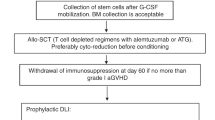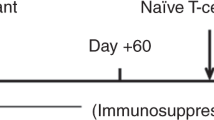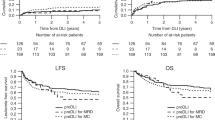Abstract
We report the outcome of early donor lymphocyte infusions (DLIs) after T-cell depleted non-myeloablative transplantation using stem cells from HLA-matched or mismatched donors. Sixty-nine patients with high-risk hematologic malignancies received DLI following fludarabine, CY and alemtuzumab with infusion of stem cells from a matched sibling (52) or partially matched family member donor (17). Patients received the first infusion at a median of 50 days after transplant, and doses ranged from 1 × 104 CD3+ cells/kg to 3.27 × 108 CD3+ cells/kg, depending on clinical status and the physician's discretion. A median cell dose of 1 × 105 CD3+ cells/kg in the mismatched setting and 1 × 106 CD3+ cells/kg in the matched sibling setting appears safe with only 1 of 7 (14%) and 4 of 31 patients (13%), respectively, experiencing severe acute GVHD at these doses. Importantly, 38% of patients with persistent disease before DLI attained a remission after infusion. Nine of the 69 patients remain alive and disease-free 32–71 months after the first DLI. In conclusion, low doses of DLI can be safely provided soon after T-cell depleted non-myeloablative therapy and provide a chance of remission. However, long-term survival still remains poor, primarily because of relapse in these patients.
This is a preview of subscription content, access via your institution
Access options
Subscribe to this journal
Receive 12 print issues and online access
$259.00 per year
only $21.58 per issue
Buy this article
- Purchase on Springer Link
- Instant access to full article PDF
Prices may be subject to local taxes which are calculated during checkout

Similar content being viewed by others
References
de Lima M, Anagnostopoulos A, Munsell M, Shahjahan M, Ueno N, Ippoliti C et al. Nonablative versus reduced intensity conditioning regimens in the treatment of AML and high risk MDS: dose is relevant to long term disease control. Blood 2004; 104: 865–872.
Martino R, Iacobelli S, Brand R, Jansen T, van Biezen A, Finke J et al. Myelodysplastic Syndrome subcommittee of the Chronic Leukemia Working Party of the European Blood and Marrow Transplantation Group. Retrospective comparison of reduced-intensity conditioning and conventional high-dose conditioning for allogeneic hematopoietic stem cell transplantation using HLA-identical sibling donors in myelodysplastic syndromes. Blood 2006; 108: 836–846.
Kottaridis PD, Milligan DW, Chopra R, Chakraverty RK, Chakrabarti S, Robinson S et al. In vivo CAMPATH—1H prevents graft versus host disease following nonmyeloablative stem cell transplantation. Blood 2000; 96: 2419–2425.
Rizzieri DA, Koh LP, Long GD, Gasparetto C, Vredenburgh J, Smith C et al. Clinical outcome and immune reconstitution following Alemtuzumab T cell depleted mismatched non-myeloablative allogeneic immunotherapy. J Clin Oncol 2007; 25: 690–697.
Giralt S, Estey E, Albitar M, van Besien K, Rondón G, Anderlini P et al. Engraftment of allogeneic hematopoietic progenitor cells with purine analogue-containing chemotherapy: harness engraft vs leukemia without myeloablative therapy. Blood 1997; 89: 4531–4536.
Slavin S, Nagler A, Naparstek E, Kapelushnik Y, Aker M, Cividalli G et al. Non-myeloablative stem cell transplantation and cell therapy as an alternative to conventional bone marrow transplantation with lethal cytoreduction for the treatment of malignant and nonmalignant hematologic diseases. Blood 1998; 91: 756–763.
Khouri IF, Keating M, Korbling M, Przepiorka D, Anderlini P, O'Brien S et al. Transplant lite induction of graft vs malignancy using fludarabine-based non-ablative chemotherapy and allogeneic blood progenitor cell transplantation as treatment for lymphoid malignancies. J Clin Oncol 1998; 98: 2817–2824.
Lacerda JF, Martins C, Carmo JA, Lourenço F, Juncal C, Rodrigues A et al. Haploidentical stem cell transplantation with purified CD34 cells after a chemotherapy-alone conditioning regimen. Biol Blood and Marrow Transpl 2003; 9: 633–642.
Passweg JR, Meyer-Monard S, Gregor M, Favre G, Heim D, Ebnoether M et al. Non-myeloablative stem cell transplantation: high stem cell dose will not compensate for T cell depletion in allogeneic non-myeloablative stem cell transplantation. Bone Marrow Transplantation 2002; 30: 267–271.
Walker C, van Burik J, De For T, Weisdorf D . Cytomegalovirus infection after allogeneic transplantation: comparison of cord blood with peripheral blood and marrow graft sources. Bio Blood and Marrow Trans 2007; 13: 1106–1115.
Rowley S, Goldberg S, Pecora A, Hsu JS, Brecher BA, Butrin L et al. Unrelated donor hematopoietic stem cell transplantation for patients with hematologic malignancies using a nonmyeloablative conditioning regimen of fludarabine, low dose total body irradiation, and rabbit anti-thymocyte globulin. Biol Blood and Marrow Transplant 2004; 10: 784–793.
Kreiter S, Winkelmann N, Schneider PM, Schuler M, Fischer T, Ullmann AJ et al. Failure of sustained engraftment after non-myeloablative conditioning with low-dose TBI and T cell-reduced allogeneic peripheral stem cell transplantation. Bone Marrow Transplantation 2001; 28: 157–161.
Ruggeri L, Cappani M, Urbani E, Peruccio K, Schlomchik WD, Tosti A et al. Effectiveness of donor natural killer cell alloreactivity in mismatched hematopoietic transplants. Science 2002; 295: 2097–2100.
Jiang Y, Barrett A, Goldman J, Mavroudis DA . Association of natural killer cell immune recovery with a graft-versus-leukemia effect independent of graft-versus-host disease following allogeneic bone marrow transplantation. Ann Hematology 1997; 74: 1–6.
Hale G, Zhang M, Bunjes D, Prentice HG, Spence D, Horowitz MM et al. Improving the outcome of bone marrow transplantation by using CD52 monoclonal antibodies to prevent GVHD and graft rejection. Blood 1998; 92: 4581–4590.
Perez-Simon JA, Kottaridis PD, Martino R, Craddock C, Caballero D, Chopra R et al. Nonmyeloablative transplantation with or without alemtuzumab: comparison between prospective studies in patients with lymphoproliferative disorders. Blood 2002; 100: 3121–3127.
Morris E, Thomson K, Craddock C, Mahendra P, Milligan D, Cook G et al. Outcomes after alemtuzumab-containing reduced intensity allogeneic transplantation for relapsed and refractory NHL. Blood 2004; 104: 3865–3871.
Rizzieri DA, Long GD, Vredenburgh J, Gasparetto C, Smith CS, Morris AK et al. Chimerism mediated immunotherapy using CAMPATH T cell depleted peripheral blood progenitor cells with nonablative therapy provides reliable, durable allogeneic engraftment. Blood 2000; 96 (Suppl 1): 2241 (abstract).
Keil F, Kalhs P, Haas O, Fritsch G, Reiter E, Mannhalter C et al. Relapse of Philadelphia chromosome positive acute lymphoblastic leukemia after marrow transplantation: sustained molecular remission after early and dose-escalating infusion of donor leukocytes. Br J Haematol 1997; 97: 161–164.
Gurman G, Arslan O, Koc H, Akan H . Donor leukocyte infusion for relapsed ANLL after allogeneic BMT and the use of interferon alpha to induce graft versus leukemia effect. Bone Marrow Transplant 1996; 18: 825–826.
Odom L, August C, Githens J, Humbert JR, Morse H, Peakman D et al. Remission of relapsed leukemia during a graft versus host reaction. Lancet 1978; 2: 537–540.
Schmid C, Labopin M, Nagler A, Bornhauser M, Finke J, Fassas A et al. Donor lymphocyte infusion in the treatment of first hematological relapse after allogeneic stem-cell transplantation in adults with acute myeloid leukemia: a retrospective risk factors analysis and comparison with other strategies by the EBMT Acute Leukemia Working Party. J Clin Oncol 2007; 25: 4938–4945.
Fielding AK, Richards SM, Chopra R, Lazarus HM, Litzow MR, Buck G et al. Outcome of 609 adults after relapse of acute lymphoblastic leukemia (ALL); an MRC UKALL12/ECOG 2993 study. Blood 2007; 109: 944–950.
Cheson B, Pfistner B, Juweid ME, Gascoyne RD, Specht L, Horning SJ et al. Revised response criteria for malignant lymphoma. J Clin Oncol 2007; 25: 579–586.
Durie BG, Harousseau JL, Miguel JS, Bladé J, Barlogie B, Anderson K et al. International uniform response criteria for multiple myeloma. Leukemia 2006; 20: 1467–1473.
Mielcarek M, Storb R . Graft-vs-host disease after non-myeloablative hematopoietic cell transplantation. Leuk Lymphoma 2005; 46: 1251–1260.
Drobyski W, Keever C, Roth M, Koethe S, Hanson G, McFadden P et al. Salvage immunotherapy using donor leukocyte infusions as treatment for relapsed chronic myelogenous leukemia after allogeneic bone marrow transplantation: effficacy and toxicity of a defined T cell dose. Blood 1993; 82: 2310–2318.
Weiden P, Flournoy N, Thomas E, Prentice R, Fefer A, Buckner CD et al. Antileukemic effect of graft versus host disease in human recipients of allogeneic marrow grafts. N Engl J Med 1979; 300: 1068–1073.
Sullivan K, Weiden P, Storb R, Witherspoon RP, Fefer A, Fisher L et al. Influence of acute and chronic graft versus host disease on relapse and survival after bone marrow transplantation from HLA identical siblings as treatment of acute and chronic leukemia. Blood 1989; 73: 1720–1728.
Martino R, Iacobelli S, Brand R, Jansen T, van Biezen A, Finke J et al. Myelodysplastic Syndrome subcommittee of the Chronic Leukemia Working Party of the European Blood and Marrow Transplantation Group. Retrospective comparison of reduced-intensity conditioning and conventional high-dose conditioning for allogeneic hematopoietic stem cell transplantation using HLA-identical sibling donors in myelodysplastic syndromes. Blood 2006; 108: 836–846.
Aversa F, Tabilio A, Velardi A, Cunningham I, Terenzi A, Falzetti F et al. Treatment of high-risk acute leukemia with T cell depleted stem cells from related donors with one fully mismatched HLA haplotype. N Eng J Med 1998; 339: 1186–1193.
Ruggeri L, Mancusi A, Capanni M, Urbani E, Carotti A, Aloisi T et al. Donor natural killer cell allorecognition of missing self in haploidentical hematopoietic transplantation for acute myeloid leukemia: challenging its predictive value. Blood 2007; 110: 433–440.
Novitsky N, Thomas V . Allogeneic stem cell transplantation with T cell depleted grafts for lymphoproliferative malignancies. Biol Blood Mar Transpl 2007; 13: 107–115.
Peggs KS, Thomson K, Hart DP, Geary J, Morris EC, Yong K et al. Dose-escalated donor lymphocyte infusions following reduced intensity transplantation: toxicity, chimerism, and disease responses. Blood 2004; 103: 1548–1556.
Morris EC, Rebello P, Thomson KJ, Peggs KS, Kyriakou C, Goldstone AH et al. Pharmacokinetics of alemtuzumab used for in vivo and in vitro T-cell depletion in allogeneic transplantations: relevance for early adoptive immunotherapy and infectious complications. Blood 2003; 102: 404–406.
Amrolia P, Muccioli-Casadei G, Huls H, Adams S, Durett A, Gee A et al. Adoptive immunotherapy with allodepleted donor T-cells improves immune reconstitution after haploidentical stem cell transplantation. Blood 2006; 108: 1797–1808.
Author information
Authors and Affiliations
Corresponding author
Rights and permissions
About this article
Cite this article
Rizzieri, D., Dev, P., Long, G. et al. Response and toxicity of donor lymphocyte infusions following T-cell depleted non-myeloablative allogeneic hematopoietic SCT from 3–6/6 HLA matched donors. Bone Marrow Transplant 43, 327–333 (2009). https://doi.org/10.1038/bmt.2008.321
Received:
Revised:
Accepted:
Published:
Issue Date:
DOI: https://doi.org/10.1038/bmt.2008.321
Keywords
This article is cited by
-
Retrospective, Landmark Analysis of Long-term Adult Morbidity Following Allogeneic HSCT for Inborn Errors of Immunity in Infancy and Childhood
Journal of Clinical Immunology (2022)
-
Phase I dose escalation study of naive T-cell depleted donor lymphocyte infusion following allogeneic stem cell transplantation
Bone Marrow Transplantation (2021)
-
Escalating-dose HLA-mismatched DLI is safe for the treatment of leukaemia relapse following alemtuzumab-based myeloablative allo-SCT
Bone Marrow Transplantation (2013)
-
Differential impact of inhibitory and activating Killer Ig-Like Receptors (KIR) on high-risk patients with myeloid and lymphoid malignancies undergoing reduced intensity transplantation from haploidentical related donors
Bone Marrow Transplantation (2012)
-
Alemtuzumab for the prevention and treatment of graft-versus-host disease
International Journal of Hematology (2011)



